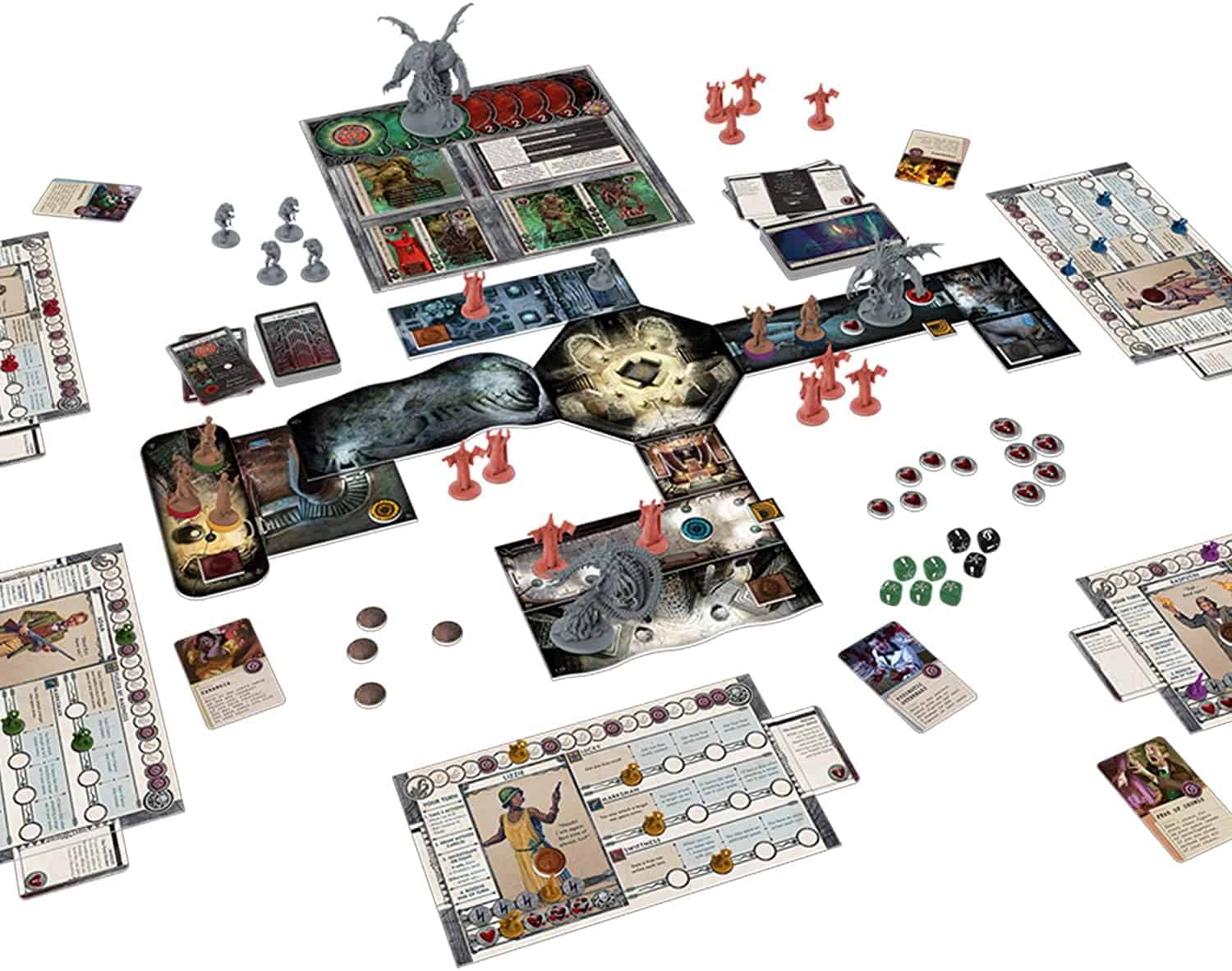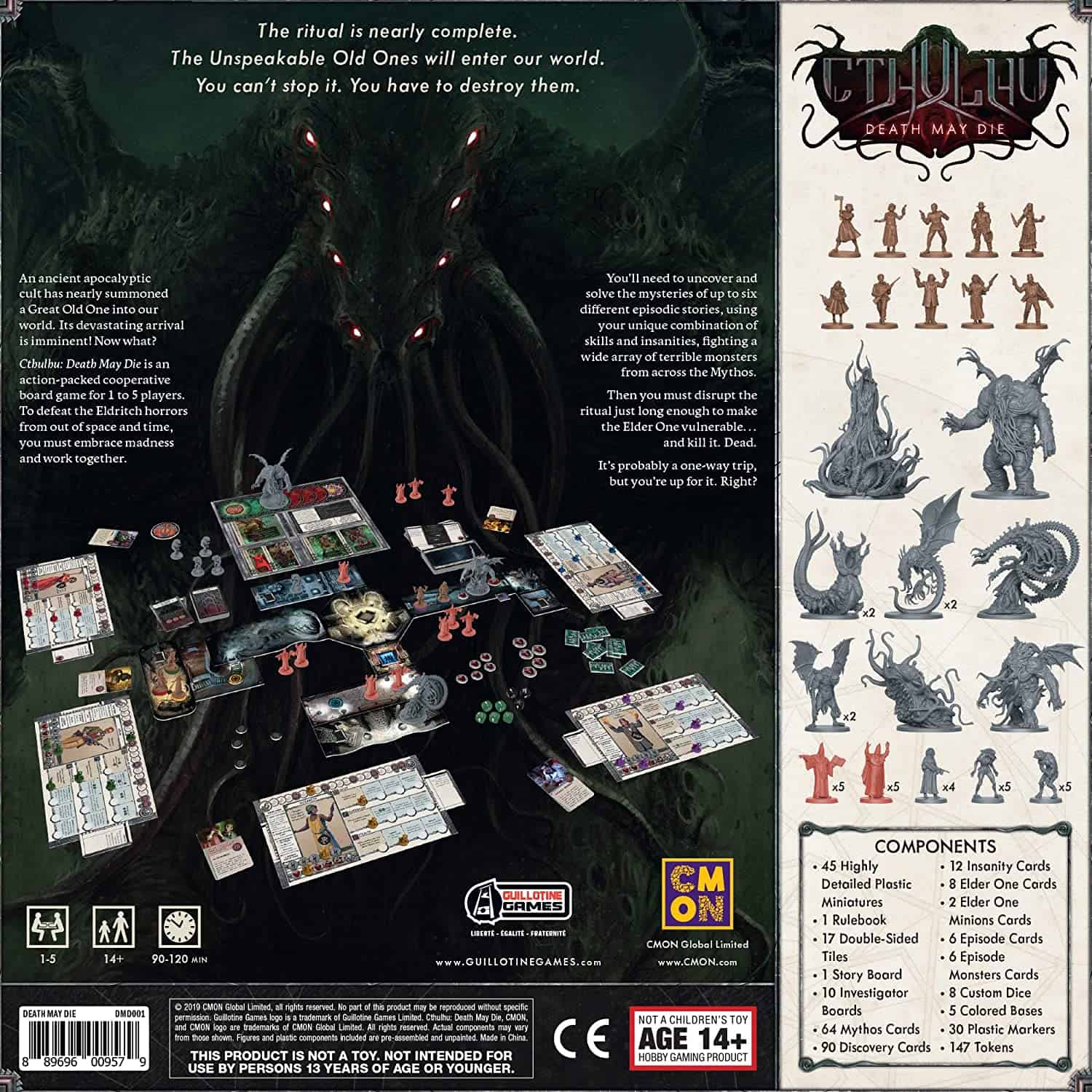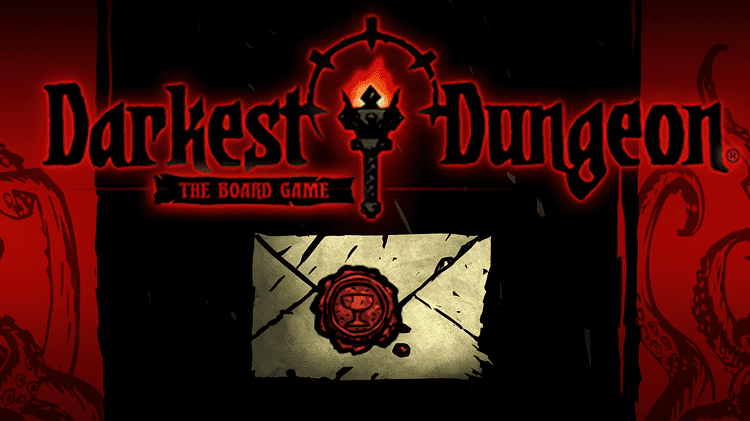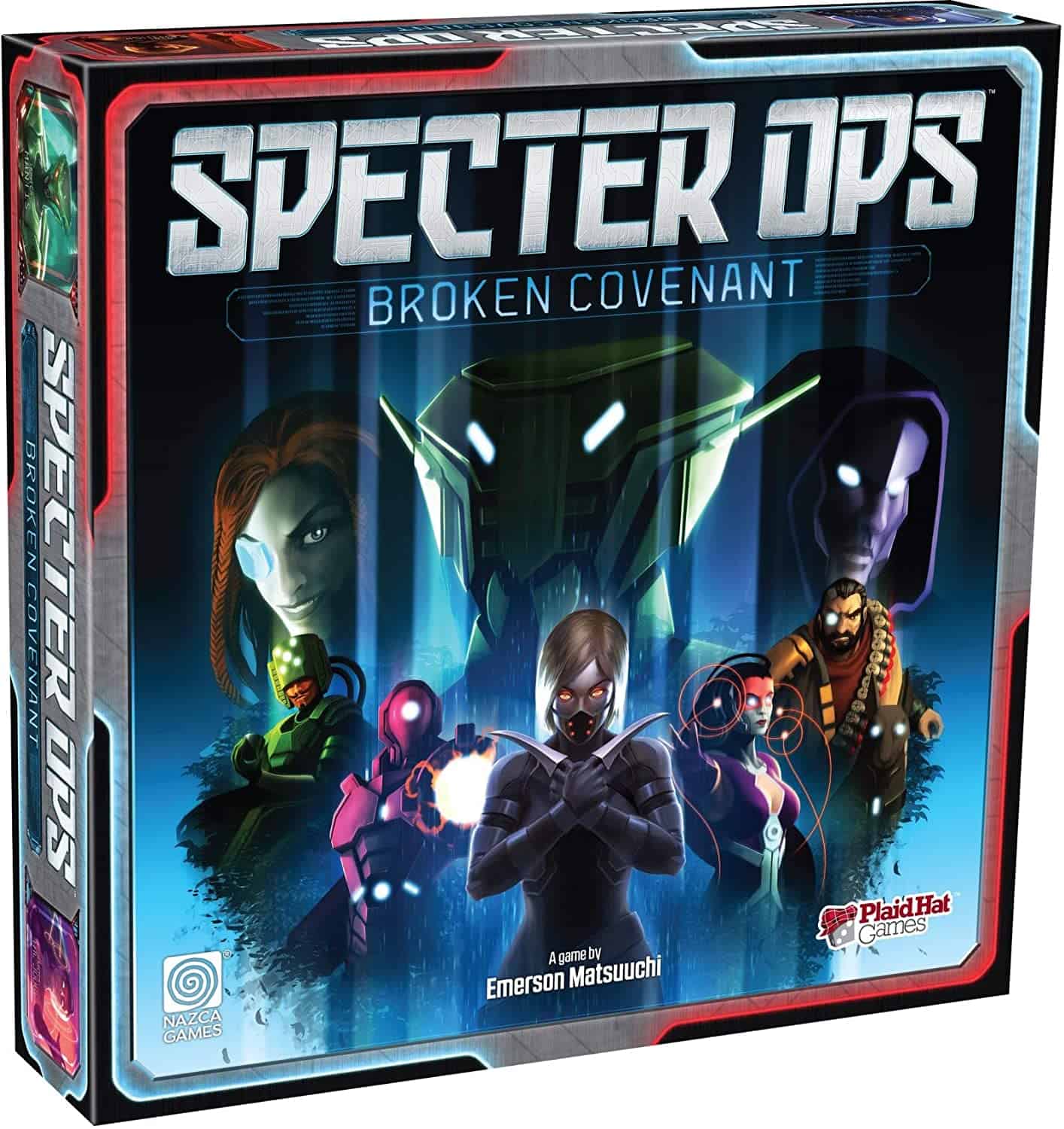H.P. Lovecraft’s reputation for writing about all things weird and wonderful is as prevalent today as it was in the early twentieth century when his stories were first published. Man, I wish I could go back in time to meet him…
While that may be impossible, there’s a new way to explore his stories and characters, which is almost as exciting as meeting the author himself. I’m talking about Cthulhu: Death May Die, a collaborative board game for one to five players inspired by Lovecraft’s writings.
It’s a game that relishes all things peculiar, from terrifying monsters to twisted cults, and that’s what makes it so brilliant. I especially like that you can play it solo, which isn’t usually an option in games as complex as this.
I’m sure you want to learn more about the creations of H.P. Lovecraft’s dark imagination, so without further ado, let’s take a closer look at the game.

Cthulhu: Death May Die: a Quick Overview
- Players: 1-5
- Recommended age: 14+
- Playing time: 90-120 minutes
Death May Die revels in the occult and all things supernatural. It has a suitably spooky storyline that positions you and your friends as potential saviors of the world…if you manage to stop the cultists’ ritual and kill the Elder One.
But you’ll have to be careful; like in Darkest Dungeon, madness is only ever a hair’s breadth away.
Aim of the Game
Win this game by killing the Elder One in its Final Stage, and you can claim the title of “savior of the world.” Lose this game, and not only do you and your fellow investigators die but so does everyone else when the Elder One is set loose upon the earth…
How to Play
Follow my expert advice, and you’ll become a master monster slayer in no time.
Setup
First, lay out the Story Board, tokens, and dice.
Choose an Elder One and place its figure on the starting space of the summoning track.
The Minions reference cards should be placed on the storyboard, then eight Mythos cards must be set out with tokens.
Make sure the Elder One Stage cards are in the correct order and put them face-up on the storyboard, with stage one on top.
Now for the fun part: choosing an Episode. Each comes with eight Mythos cards, an Episode card, fifteen Discovery cards, and tokens.
Place the Monsters reference cards on the Story Board in a pile.
On the back of the Episode card, you’ll find the layout for the map. Follow these instructions, turn over the card and place it on the Story Board.
After this, shuffle the Mythos cards, place them face-down, and do the same with the Discovery deck. Lots of shuffling, but don’t worry, we’re almost done now!
Each player must choose an investigator board and matching figure, which should be placed on the starting space.
If you’re playing on your own (which I’d recommend trying, though maybe not the first time you play), you’ll need to pick two investigators.
Locate the six markers of your color and place them on your investigator board.
The insanity cards, which should always be treated with the utmost caution, must be shuffled. Deal one to each player. Now you’re ready to play!
Unlike some other games, there are no rules about who goes first; you can decide on any player. My friends and I usually toss a coin, or if we have a little more time on our hands, we choose whoever can tell the best ghost story.

Game Concepts
I’ll quickly talk you through the most critical game concepts.
Episodes
Each Episode comes with its own set of Episode cards, Mythos cards, Discovery cards, and special tokens.
Elder Ones
Likewise, there are a few Elder Ones to choose from, each of which comes with its own monsters and cultists.
Discovery Cards
There are fifteen Discovery cards in each Episode, including Companions, Items, and Conditions.
Mythos Cards
Trust me, after you’ve played Death May Die just one time, you will hate these cards. You’ll hate them more than you hate anything else in the world. Why? They are responsible for all the horrible things in the game (of which there are many).
Some of these cards will summon enemies, while others might cause you to go mad.
Enemies
When I say enemies, I’m referring to monsters, cultists, and the Elder One. *Shivers*
Investigators
Each investigator comes with a board showing:
- A wound track – if the marker on your track reaches the skull, you are dead
- Skills – these can be used to bend the rules in your favor
- A stress track – use this to your own benefit by increasing one stress to re-roll the die
- A sanity track – if the marker on your track reaches the skull, you are destroyed by madness and eliminated from the game
Spaces and Tiles
Understanding how to navigate tiles and spaces is crucial.
Tiles are double-sided and labeled to help you set up the game. Walls and passages define “spaces” – some tiles contain just one space, while others include two or three.
You can only move through passages with connecting arrows on both spaces when you move around the board.
Still with me? Good.
On each map, you’ll see three gates: blue, yellow, and red. Avoid them like the plague! This is where enemies will emerge.
You can also use staircases and tunnels to move from one place to another, providing that both places have matching tokens. (This part of the game is cool; I love secret tunnels!)
Dice and Checks
Specific actions and Discovery cards require you to roll three black dice, each of which has four possible results:
- Success – if you’re attacking an enemy, you win; if they are attacking you, they win
- Elder sign – you need a skill or card that uses this for it to be relevant
- Tentacle – lose one sanity and move your tracker to the right
- Blank – no effect
If you don’t like the result and can afford to do so, I’d recommend paying one stress to re-roll the dice. Your second roll could end up putting you in a much stronger position.

Taking a Turn
There are four steps in a turn:
- Take three actions
- Draw a Mythos card
- Investigate or fight
- Resolve end of turn
Take Three Actions
The good news is you can take the same action more than once if you want to. Four actions are available in each Episode, two of which are unique.
Run – move up to three spaces as long as there is a passage on both tiles. Unfortunately, if you’re leaving one space with enemies, I’ve got bad news: those enemies will chase you to the new space. Sorry!
Attack – choose an enemy in your space to target and make a roll. If you succeed, place wound tokens by the base of the figure you attacked.
Don’t forget, the Elder One can only be attacked once you have successfully disrupted the ritual!
Rest – you can only rest when you’re in a safe space, meaning there are no enemies with you. You can heal your health and/or stress up to three spaces in total, not per track.
Trade – you can trade any number of Companions and Items with your fellow players.
Draw a Mythos Card
Take the Mythos card from the top of the deck and resolve it.
These cards have several steps, which must be carried out from top to bottom. If there’s a step you can’t carry out, you can skip it and move on to the next one.
If you draw a card that summons the Elder One, you can relax (for now) because these only have an effect later, at the end of the turn. When you discard it, make sure the card is still visible.
Investigate or Fight
What happens next depends on where you are. If there are no enemies around you, you’re safe and can spend time exploring.
Draw a Discovery card and follow the instructions on it.
Top tip: if you suffer from any wounds, you can apply these to your Companions instead. This can be useful, but Companions cannot heal; if their wounds equal the number on their cards, they have to be discarded.
On the other hand, if you’re in a space occupied by enemies, it’s time for a fight! This next part is sadistic: rather than drawing a Discovery card, your enemies attack you in an order of your choice.
You’ll need to roll the number and type of dice specified on your enemy’s card for each attack. Each success gives you one wound; each tentacle costs you one sanity.
Resolve Your Turn
Any effects that happen at the end of a turn (apart from Elder One effects) take place now. You can choose the order of these effects.
Did I mention you might also be on fire? This happens when you leave a space containing Fire Tokens.
Roll one standard die for each token on your investigator board.
Next, it’s time to check the Mythos discard pile because, man, I have some bad news for you…if there are three cards in the pile with the Elder One summoning symbol, the Elder One advances toward ultimate power!
So, when is the Elder One actually summoned? This happens when:
- The Elder One enters the first red space on the track
- The ritual is disrupted
Death of an Investigator
Sadly, when an investigator dies, the game ends if the Elder One is on the summoning track. However, if the Elder One has already been summoned, the rest of the investigators can continue playing the game.
Fighting the Elder One
The Elder One behaves like an enemy, attacking unfortunate investigators who finish their turn in its space. It cannot be attacked or damaged until the ritual has been disrupted.
The process of destroying the Elder One involves multiple Stages with individual health. These Stages must be defeated one at a time, which happens when the Stage has wounds equal to or greater than its health.
End of the Game
If you and your fellow investigators defeat the Elder One’s final Stage, you win! You have saved the world from unspeakable evil and carnage.

How Many Pieces Are There in Cthulhu: Death May Die?
You’ll find the following components in the box:
- 17x double-sided tiles
- 12x Insanity cards
- 5x Bonus dice
- 3x Standard dice
- 30x Tentacle markers
- 5x colored bases
- Storyboard
- 1x Starting space token
- 26x Wound tokens
- 3x Gate tokens
- 1x Progression token
- 2x Staircase tokens
- 2x Tunnel tokens
- 6x Level 1 Skill tokens
- 8x Fire tokens
- 6x Episode boxes
- 10x Investigators
- 18x Monsters
- 10x Cultists
Alternatives to Cthulhu: Death May Die
I’d recommend these games if you like Death May Die.
Darkest Dungeon

Darkest Dungeon is, in my opinion, even more terrifying than Death May Die. It features everything that makes horror games great: creepy dungeons, monsters, an old manor house that’s probably (definitely) haunted…you get the picture. If you like Death May Die, you’ll love Darkest Dungeon.
Find out more (if you dare!) in our Darkest Dungeon guide.
- Players: 1-4
- Recommended age: 14+
- Playing time: 90-120 minutes
Specter Ops

Here’s another sci-fi game to add to your arsenal. Specter Ops is an action-packed game brimming with tactical complexity. Like Death May Die, it’s a visually stunning game that comes with detailed miniatures. Can you and your teammates track down the infiltrator who walks among you in the Raxxon Global pharmaceutical facility?
Interested? You should be! Don’t forget to read our complete Specter Ops guide.
13 Dead End Drive

If Death May Die sounds a little too intense for you, this is my alternative suggestion. 13 Dead End Drive combines typical horror elements – an old mansion, secret corridors – with a more lighthearted approach. The aim of the game is to inherit mysterious Aunt Agatha’s fortune.
For a thorough overview of the game, read our 13 Dead End Drive guide.
Frequently Asked Questions
Question: Can I play Cthulhu: Death May Die solo?
Answer: Yes, you can! You’ll need to take on the role of two investigators to play on your own.
Click here to find more solo board games.
Question: Is Cthulhu: Death May Die a legacy game?
Answer: It isn’t a legacy game; it’s a cooperative strategy game.
Question: How long does it take to play Cthulhu: Death May Die for the first time?
Answer: When you’re just starting and learning the rules, it’s likely to take around two hours for a complete game.
Question: Should I apply the Elder One advancement effects even when he’s on the board?
Answer: Yes, you should. It’s essential to follow all the steps as you usually would.
Question: How many green dice can I roll?
Answer: There is no limit; if there aren’t enough dice, remember your previous results and re-roll.
Question: Can I play Cthulhu: Death May Die with more than five people?
Answer: Unfortunately not, but there are plenty of board games that allow you to play with more people.

Recommended Reads:
- Stratego Pieces Explained – Must-Know Facts - February 28, 2023
- Wahoo Board Game Guide – AKA Aggravation Guide - February 22, 2023
- Pokemon Monopoly Guide - February 22, 2023

